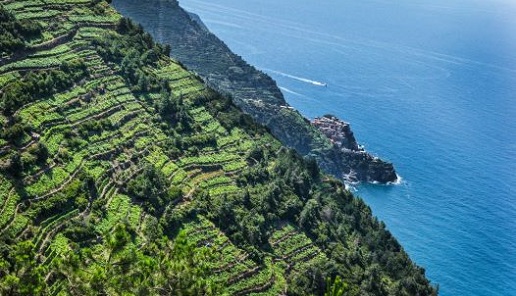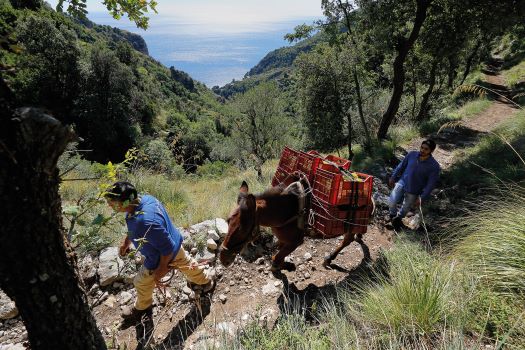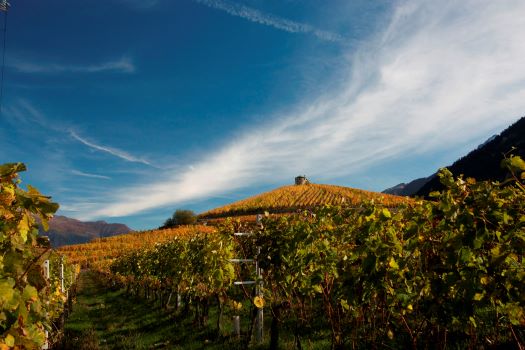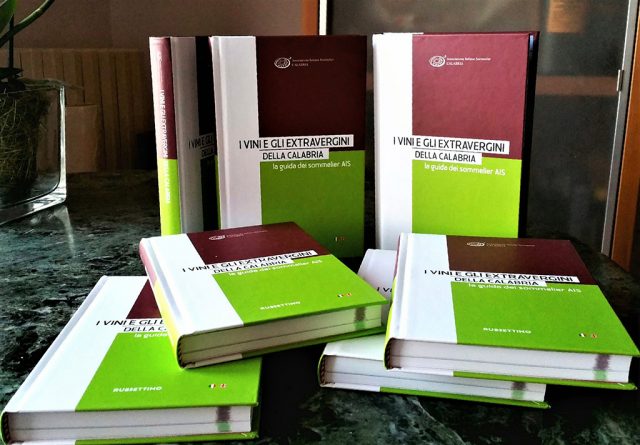Heroic Harvests 2022. Biodiversity as an answer to climate change

Drought and heat are challenging all of Italian viticulture. Heroic viticulture seems to be responding better to these issues, but it suffers the other major complication of this vintage: rising costs and labor shortages.
It is a "bipolar" Italian heroic viticulture that is painted by the report of Cervim, the Center for Research, Studies, Safeguarding, Coordination and Valorization for Mountain Viticulture, which observes the wineries practicing heroic viticulture in Italy on the current harvest trend. While on the one hand the heroic vineyard, which is more resilient and integrated into its surroundings, seems to reassure producers, with plants that are responding quite well to the drought and high temperatures of this extreme season, on the other hand the "usual" problems that plague this type of viticulture are being loudly heard. But let's see in detail.
.jpg) Harvesting is occurring much earlier (as much as 15 days earlier than in earlier vintages) in the north, particularly in Valle d'Aosta, home of Cervim, where so far production reveals a 30 percent drop due to drought, despite the possibility of resorting to emergency irrigation throughout the summer, which affects about half of the Valle d'Aosta vineyard. "The quantity is declining throughout the region," stresses Stefano Celi, Cervim president and a winemaker in Valle d'Aosta, "those who were able to do relief irrigation did not suffer significant decreases in product; for those who did not have this possibility, especially in the terraces and terraces where there is less drainage, the productions are really poor. The torrid year for now does not seem to have affected the quality of the grapes, as observed at the Les Cretes winery in Aymavilles (AO) where the Chardonnay harvest began on August 16. "The grapes are beautiful but weigh very little," says Giulio Corti, sales manager, "on an 18-kg box we get up to 15 kg: the box is full the same, but the weight is less because the berries are smaller and with little juice. Everything is concentrated: sugars, acidity, mineral salts... these are parameters that we will have to manage carefully in the winery." They are more serene in the south, particularly where older plantings recur, as in Antioco Island (Carbonia-Iglesias), where the 100-year-old vines have reacted naturally to climate change. "On the island, we cannot provide irrigation, even if it is granted," says Sardus Pater Winery President Raffaele De Matteis, "so the choice to have continued on planting distances considered archaic has been the secret to maintaining the vines. Although here, as in many other territories, the real unknown remains the timing of grape ripening, put on "stand-by" by the plant, which reduces its vital functions to protect itself.
Harvesting is occurring much earlier (as much as 15 days earlier than in earlier vintages) in the north, particularly in Valle d'Aosta, home of Cervim, where so far production reveals a 30 percent drop due to drought, despite the possibility of resorting to emergency irrigation throughout the summer, which affects about half of the Valle d'Aosta vineyard. "The quantity is declining throughout the region," stresses Stefano Celi, Cervim president and a winemaker in Valle d'Aosta, "those who were able to do relief irrigation did not suffer significant decreases in product; for those who did not have this possibility, especially in the terraces and terraces where there is less drainage, the productions are really poor. The torrid year for now does not seem to have affected the quality of the grapes, as observed at the Les Cretes winery in Aymavilles (AO) where the Chardonnay harvest began on August 16. "The grapes are beautiful but weigh very little," says Giulio Corti, sales manager, "on an 18-kg box we get up to 15 kg: the box is full the same, but the weight is less because the berries are smaller and with little juice. Everything is concentrated: sugars, acidity, mineral salts... these are parameters that we will have to manage carefully in the winery." They are more serene in the south, particularly where older plantings recur, as in Antioco Island (Carbonia-Iglesias), where the 100-year-old vines have reacted naturally to climate change. "On the island, we cannot provide irrigation, even if it is granted," says Sardus Pater Winery President Raffaele De Matteis, "so the choice to have continued on planting distances considered archaic has been the secret to maintaining the vines. Although here, as in many other territories, the real unknown remains the timing of grape ripening, put on "stand-by" by the plant, which reduces its vital functions to protect itself.
 As anticipated, the unpredictability of a "crazy" vintage is compounded by the well-known difficulties that plague this type of viticulture, namely management burdens and finding labor, "a situation further exacerbated-as Stefano Celi explains-by the general context, with rising production costs, particularly energy and fuel, which have increased both irrigation and processing costs and raw materials; added to this is the poor availability of bottles." "We can't find people who can withstand the heaviness of heroic viticulture, all by hand and in extreme conditions, not suitable for those who suffer from vertigo," adds Andrea Ferraioli, owner and agronomist of the Marisa Cuomo winery, located in Furore, on the Amalfi Coast, where the vineyards overlook the cliffs. Despite this, the producer's faith in heroic viticulture as the viticulture of tomorrow is unsinkable: "here it is biodiversity that safeguards the vines. Ours are free-standing vines, which are more than 80 years old, they react to the heat in a natural way, taking advantage of the moisture created in the dry stone walls that support them and in the steaming of the sea; the pergolas do the rest by keeping the soil shaded." An emblem of heroic viticulture, the dry stone wall becomes a precious reservoir of moisture and biodiversity, as well as an indispensable support in territories with a high hydrogeological risk, such as the Cinque Terre, Valle d'Aosta, Valtellina or Lunigiana, where the loss of viticulture would mean loss of identity and landscape, with dangerous consequences and costs for the entire community.
As anticipated, the unpredictability of a "crazy" vintage is compounded by the well-known difficulties that plague this type of viticulture, namely management burdens and finding labor, "a situation further exacerbated-as Stefano Celi explains-by the general context, with rising production costs, particularly energy and fuel, which have increased both irrigation and processing costs and raw materials; added to this is the poor availability of bottles." "We can't find people who can withstand the heaviness of heroic viticulture, all by hand and in extreme conditions, not suitable for those who suffer from vertigo," adds Andrea Ferraioli, owner and agronomist of the Marisa Cuomo winery, located in Furore, on the Amalfi Coast, where the vineyards overlook the cliffs. Despite this, the producer's faith in heroic viticulture as the viticulture of tomorrow is unsinkable: "here it is biodiversity that safeguards the vines. Ours are free-standing vines, which are more than 80 years old, they react to the heat in a natural way, taking advantage of the moisture created in the dry stone walls that support them and in the steaming of the sea; the pergolas do the rest by keeping the soil shaded." An emblem of heroic viticulture, the dry stone wall becomes a precious reservoir of moisture and biodiversity, as well as an indispensable support in territories with a high hydrogeological risk, such as the Cinque Terre, Valle d'Aosta, Valtellina or Lunigiana, where the loss of viticulture would mean loss of identity and landscape, with dangerous consequences and costs for the entire community.
 With all its complexities, then, heroic viticulture nonetheless stands as an effective response to climate change, because inherent in it is that concept of "good agriculture" as "the only means of appeasing the vagaries of the weather while guaranteeing the plant's well-being," as Francesco Bordini, a consultant and producer in Modigliana, Romagna, says, where he has run the Villa Papiano winery since 2001, with heroic vineyards nestled close to the Apennine ridges that separate Romagna from Tuscany. "Since ancient Egyptian times, water has been considered a treasure and the floods of the Nile considered worthy of veneration," explains the winemaker, who also practices biodynamics, "Respect for the land, the enhancement of organic matter, nutritional balances, the care of the canopy, the relationship between variety-clone and rootstock, the relationship with the animal and microbiological component, as well as the fundamental time to be devoted to observation, are just some of the members of a complex "agricultural organism" in which balance is the winner."
With all its complexities, then, heroic viticulture nonetheless stands as an effective response to climate change, because inherent in it is that concept of "good agriculture" as "the only means of appeasing the vagaries of the weather while guaranteeing the plant's well-being," as Francesco Bordini, a consultant and producer in Modigliana, Romagna, says, where he has run the Villa Papiano winery since 2001, with heroic vineyards nestled close to the Apennine ridges that separate Romagna from Tuscany. "Since ancient Egyptian times, water has been considered a treasure and the floods of the Nile considered worthy of veneration," explains the winemaker, who also practices biodynamics, "Respect for the land, the enhancement of organic matter, nutritional balances, the care of the canopy, the relationship between variety-clone and rootstock, the relationship with the animal and microbiological component, as well as the fundamental time to be devoted to observation, are just some of the members of a complex "agricultural organism" in which balance is the winner."
Translated with: https://www.deepl.com/

 Italiano
Italiano








